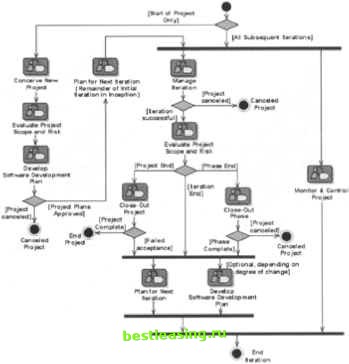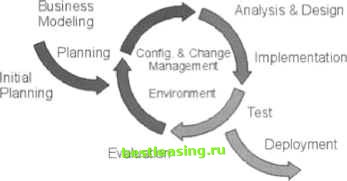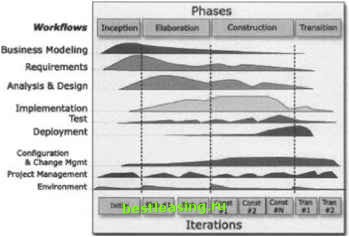

 |
 |

|
Промышленный лизинг
Методички
Rational Unified Process (RUP) Project Framework The Rational Unified Process, or more affectionately referred to as RUP, is a customizable project methodology framework aimed primarily at software development. It is a complete software development process framework that comes with several out-of-the-box examples. Processes derived from RUP vary from lightweight which address the needs of small projects to more complex heavyweight projects. To date, projects of all sizes have successfully used RUP. This methodology enhances team productivity and delivers software best practices to the project team through a set of components, which in turn consist of guidelines, templates, and best practices from thousands of development projects. From large-scale enterprise to agile projects, RUP allows organizations to develop projects more rapidly and deliver quality even when using this process. Table 3.1 and Figure 3.2 show key areas that make up RUP. Table 3.1: The components of the RUP framework 4 phases 8 iterations (minimum) 9 workflows 57 activities 270 activity steps (approximately) 114 artifacts 38 roles (up to 38 people)  Figure 3.2: RUP project management process. Source: Life Cycles of the Rational Unified Process. Reprinted with permission. RUP is not merely a process. It is valuable because it embodies many of the best project management practices available today, thereby making it a flexible framework to which project managers can apply their solutions. In other words, you could consider RUP to be a road map for project managers, analysts, testers, and so on. This allows resources to use a common project management terminology and a component kit on how to manage projects. If you already know project management, RUP merely becomes a checklist. However, if you are new to project management, RUP gives you a nice overview. Companies such as Wells Fargo and Merrill Lynch and numerous others have used RUP successfully (see Figure 3.3). Requirements  Figure 3.3: RUP cycle. Source: Life Cycles of the Rational Unified Process. Reprinted with permission. The preferred approach to using RUP is to first determine what is missing from the organizations project management environment. After this assessment has been completed, decide how much change the organization can handle. For example, if a companys biggest problem is requirements gathering, RUP offers this process. When this company starts using RUP, you can reassess how successful their requirements-gathering process has worked. Over time, a RUP-based project goes through four distinct phases: inception, elaboration, construction, and transition. Each phase contains one or more iterations. In each iteration, efforts are expended in various amounts to each of several disciplines (or workflows) such as requirements, analysis and design, testing, and configuration management. The key advantage of RUP is reduction of risks (see Figure 3.4).  Figure 3.4: RUP life-cycle phases comparison. Source: Life Cycles of the Rational Unified Process. Reprinted with permission. Virtually any company can use and customize RUP to suit the needs of its projects. This implies that RUP is as heavy or light as the project wants to go. The implementation of RUP could take from a few weeks to a few years, depending on how much process is required. Above all, use common sense when implementing RUP, as no major tools and techniques are needed. In the future, many companies will use RUP as a project management framework, whereby they can hang their best practices. RUP also provides information to help in using other Rational tools for better software development, but does not require the Rational toolset for effective application to an organization. It, therefore, allows you to tailor the process if none of the out-of-the-box road maps suit your organization or project. RUP emphasizes the adoption of certain best practices of modern software development as a way to reduce the risk inherent in developing new software. These best practices are: Develop iteratively. Manage requirements. Use component-based architectures. Model visually. Continuously verify quality. Control change. 1 2 3 4 5 6 7 8 9 10 11 12 13 14 15 16 17 18 19 20 21 22 23 [ 24 ] 25 26 27 28 29 30 31 32 33 34 35 36 37 38 39 40 41 42 43 44 45 46 47 48 49 50 51 52 53 54 55 56 57 58 59 60 61 62 63 64 65 66 67 68 69 70 71 72 73 74 75 76 77 78 79 80 81 82 83 84 85 86 87 88 89 90 91 92 93 94 95 96 97 98 99 100 101 |